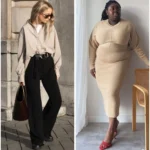Minimalist fashion is transforming the way we approach clothing, promoting a sustainable lifestyle by emphasizing quality over quantity.
This movement encourages individuals to curate a wardrobe with essential, versatile pieces, reducing waste and environmental impact.
Influential figures like Stella McCartney and organizations such as Eco-Age are spearheading this change, advocating for eco-friendly materials and ethical production practices.
By embracing minimalist fashion, consumers contribute to a more sustainable and mindful approach to dressing, particularly in women’s apparel, fostering a responsible and stylish wardrobe.
Why Minimalist Fashion Matters for a Sustainable Lifestyle
Minimalist fashion matters because it reduces environmental impact and promotes ethical consumption.
Organizations like Eco-Age and movements such as Fashion Revolution highlight the importance of sustainable practices.
For example, adopting a minimalist wardrobe can decrease textile waste by up to 30%, supporting a healthier planet and a more responsible fashion industry.
Additionally, focusing on minimalist women’s clothing ensures that fashion choices are both stylish and sustainable, addressing the unique needs of women while promoting eco-friendly shopping habits.
Understanding the Key Components of Minimalist Fashion
Key Elements of Minimalist Fashion
- Quality Over Quantity: Focus on durable, high-quality garments that last longer.
- Neutral Colors: Utilize a versatile color palette for easy mixing and matching.
- Timeless Designs: Choose classic styles that remain stylish across seasons.
- Sustainable Materials: Opt for eco-friendly fabrics like organic cotton and recycled polyester.
- Ethical Production: Support brands that ensure fair labor practices and reduce environmental harm.
- Versatile Women’s Clothing: Select pieces that cater specifically to women’s fashion needs, offering both functionality and elegance.
- Designer Collaborations: Embrace collections from fashion designers who prioritize minimalist and sustainable principles.
These components work together to create a cohesive, sustainable wardrobe that minimizes waste and maximizes utility, especially in women’s apparel where versatility and style are paramount.
Common Considerations in Adopting Minimalist Fashion
Considerations in Minimalist Fashion
Transitioning to a minimalist wardrobe involves thoughtful planning and intentional choices:
- Investment in Quality: High-quality items offer long-term value and durability.
- Versatile Selections: Finding pieces that suit various occasions enhances wardrobe flexibility.
- Evolving Consumer Preferences: Adapting purchasing behaviors supports sustainable choices.
- Brand Selection: Choosing brands that align with minimalist and sustainable values ensures consistency.
- Variety within Simplicity: A limited color palette and streamlined styles can still offer diverse looks.
- Focus on Women’s Apparel: Selecting minimalist designs tailored for women ensures both style and sustainability.
- Designer Partnerships: Collaborating with fashion designers who embrace minimalist principles enhances wardrobe quality and sustainability.
Addressing these considerations is essential for successfully embracing a minimalist and sustainable lifestyle, particularly in the realm of women’s clothing where personal style and functionality intersect.
Strategies for Overcoming Challenges in Minimalist Fashion
Strategies for Overcoming Challenges in Minimalist Fashion
- Invest Wisely: Prioritize purchasing high-quality staples that offer long-term value.
- Plan Your Wardrobe: Create a capsule wardrobe to ensure all pieces are versatile and complementary.
- Educate Yourself: Learn about sustainable brands and their practices to make informed choices.
- Gradual Transition: Slowly reduce wardrobe size to adapt comfortably without feeling restricted.
- Support Ethical Brands: Choose companies committed to sustainability and ethical production.
- Mix and Match: Enhance variety by creatively combining existing garments in different ways.
- Embrace Second-Hand: Explore thrift stores and online platforms for unique, sustainable fashion finds.
- Choose Designer Collections: Invest in minimalist collections from renowned fashion designers who prioritize sustainability.
- Focus on Women’s Fashion: Select pieces specifically designed for women’s apparel to ensure both style and functionality.
Implementing these strategies can facilitate a smooth transition to a minimalist wardrobe, enhancing sustainability and ensuring that women’s clothing needs are met with style and responsibility.
Real-World Examples and Case Studies of Minimalist Fashion
Examples of Success in Minimalist Fashion
Stella McCartney: Renowned for integrating sustainable materials and ethical practices, McCartney’s designs set industry standards for minimalist fashion. Her collaborations with eco-friendly brands showcase how high fashion can embrace sustainability without compromising on style.
Everlane: This brand emphasizes transparency and quality, offering minimalist pieces that are both stylish and sustainable. Everlane’s commitment to ethical production and versatile designs makes it a leader in the minimalist fashion movement.
Patagonia: Known for its durable outdoor clothing, Patagonia champions minimalist design and environmental responsibility through initiatives like their Worn Wear program. Their focus on timeless, functional apparel exemplifies the principles of minimalist fashion.
Cuyana: With the mantra “fewer, better,” Cuyana creates elegant women’s clothing that emphasizes quality and sustainability. Their capsule collections provide versatile options that cater specifically to women’s fashion needs, promoting a minimalist and eco-friendly wardrobe.
COS (Collection of Style): Part of the H&M group, COS offers modern, functional, and considered design. Their minimalist collections for women feature timeless pieces that blend style with sustainability, appealing to eco-conscious consumers.
These examples demonstrate how embracing minimalist fashion can lead to both business success and positive environmental impact, especially within the women’s apparel sector.
Frequently Asked Questions About Minimalist Fashion
Frequently Asked Questions About Minimalist Fashion
What is minimalist fashion?
Minimalist fashion focuses on a streamlined wardrobe with essential, versatile pieces, emphasizing quality and sustainability over quantity.
How can businesses benefit from minimalist fashion?
Businesses can reduce production costs, appeal to eco-conscious consumers, and enhance brand reputation by adopting minimalist and sustainable practices.
What are the common considerations in minimalist fashion?
Considerations include investing in quality, selecting versatile pieces, evolving consumer preferences, choosing aligned brands, maintaining variety within simplicity, focusing on women’s apparel, and partnering with designers who embrace minimalist principles.
How does minimalist fashion support environmental sustainability?
By reducing the number of garments produced and consumed, minimalist fashion decreases textile waste, lowers carbon footprints, and encourages the use of eco-friendly materials, contributing to a healthier planet.
What role do fashion designers play in minimalist fashion?
Fashion designers create collections that embody minimalist principles, focusing on timeless designs, sustainable materials, and ethical production practices, thereby driving the movement forward.
Key Takeaways for Minimalist Fashion
Key Takeaways for Minimalist Fashion
- Environmental Impact: Minimalist fashion significantly reduces textile waste and promotes sustainability.
- Quality Focus: Investing in high-quality, timeless pieces ensures a durable and versatile wardrobe.
- Ethical Practices: Supporting brands that prioritize ethical production fosters a responsible fashion industry.
- Practical Strategies: Implementing strategies like wardrobe planning and supporting second-hand markets can ease the transition to minimalism.
- Influential Figures and Organizations: Leaders like Stella McCartney and organizations such as Eco-Age drive the minimalist fashion movement forward.
- Women’s Apparel: Focusing on minimalist women’s clothing ensures that style and sustainability go hand in hand.
- Designer Collaborations: Partnering with fashion designers who embrace minimalist and sustainable principles enhances wardrobe quality and ethical standards.
By understanding and applying these key points, individuals can successfully embrace minimalist fashion and contribute to a sustainable lifestyle.
Minimalist fashion offers a practical and sustainable approach to modern living, emphasizing quality, versatility, and ethical practices.
By reducing wardrobe clutter and supporting eco-friendly brands, especially in women’s clothing, individuals can make a positive impact on the environment and their personal well-being.
Influential figures and organizations continue to champion this movement, making sustainable and minimalist fashion more accessible and appealing. Embrace minimalist fashion today to foster a more sustainable and mindful lifestyle.







